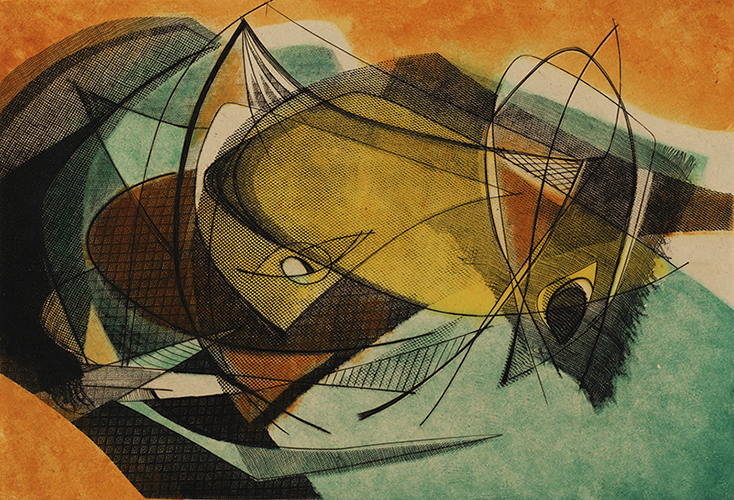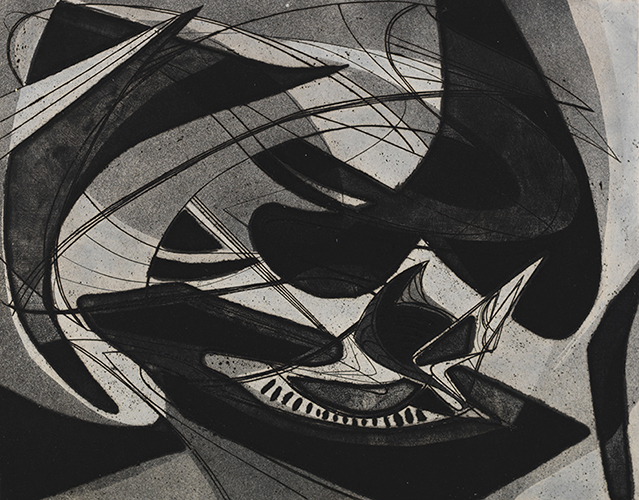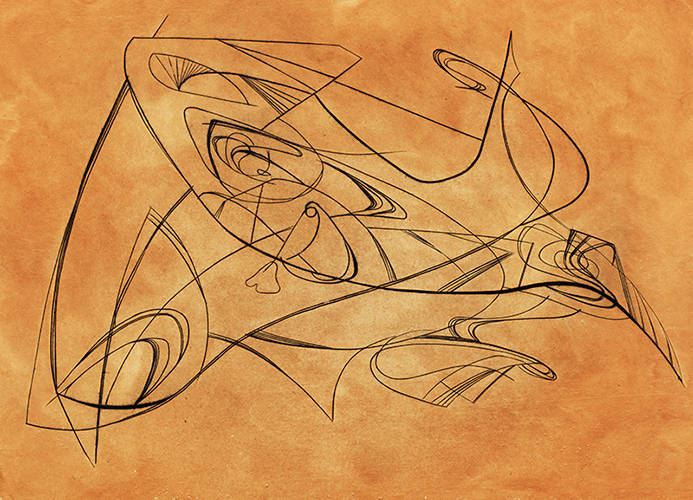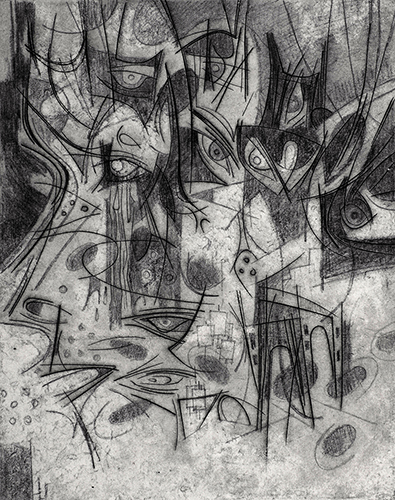Copper Engraving
After his success in the Kolkata episode through wood-engraving, he did some work in Dhaka. However after going to London, Safiuddin Ahmed did not use this medium anymore. The higher education he received through engraving in London was no longer in wood, but in metal or copper. This method is used to cut deep shallow lines with the help of burning the copper. That is the ultimate meaning of cutting a line in metal. There is no chance to create a new line, or remove. It is especially important to have the strength and control of the hand to cut the desired line in metal. Safiuddin Ahmed proved his diligence in opper engraving as well. In the period 1957-58, he composed: ‘Jeler shopno’, ‘Holud Jal’, ‘Composition’ and ‘Guntana’.

The name of the first engraving painting in London was ‘Prisoner’s Dream’ (1957). The image of boat, fisherman and fish has been used in this picture. The familiar figure has been twisted in such a way that the image of the fish in the centre of the image is actually the foot of the prison. In this picture, various dimensions and variations of various lines have been highlighted. One line is passing over another line or the lines are twisting. The painting is made in the shape of a fish, again broken and distorted. This figure shows how the line can be used. The shape of the fish is arranged in the form to the right of the image. This painting has gone through several stages before it was finalized. The artist has three such levels of print. From it, the artist’s point of view and experimentation can be understood. The artist first composes some lines by thinking of a subject. In it we notice the arrangement of thin, fine and slightly thick lines. As the scope of the content increases, so does the amount of lines. Then the structure of the whole picture gradually became clear in the artist’s thinking. It creates a balance and smooth arrangement of various shapes, ranges and formations. This process is noticeable in this figure. In the first stage we see the use of lines that create tension and counter tension in the image. Besides, the tendency of creating counter forms against various shapes is also noticeable. The structures are interrelated. The feature that the figure in the artist’s paintings has become blurred after going to London is also noticeable in this painting. Forms have prevailed instead.
In the second stage of the painting, the line has been extended keeping the original structure of the composition intact. The sharpness of a single and light line has made dual, dense and strong somewhere. Perfection has been given to the imperfect line. As a result, the image has become more beautiful, meaningful and expressive. In the third stage we see only the use of colour. Only one colour was used. The colour is very light in the centre of the image, the darker the colour as it moves towards the edges. This technique of throwing light in the centre of the image is also noticeable in the next few images.
In addition to engraving, the process of creating textures with soft ground varnish is also used in the painting ‘Holud Jal’ (1957). As the symbolic layout of the net is presented with the lines, the atmosphere of the net has been made more extensive by leaving the imprint of socks and mosquito nets on the metal in the process of soft ground varnish. The cloth has been used somewhere once, somewhere more than once. Darker tones have been created where it has been used more than once. The clothes have been torn in one place on the right side. The whole image has been brought to the foreground on the right. There’s the end of the net, there’s the fish’s eye. The symbol of the small boat has been used as the image inside. In this figure, there is a strong motion between the lines drawn through engraving. The speed at which the net is lifted and lowered in the water is illustrated here by the line. Moreover, the various angles that are created while pulling the net are also used in this figure. In the second stage, various colours have been used in the image: red, blue, yellow etc. This use of colour was not to the artist’s liking, so he went to the third stage and changed it. Reduces the colour level a lot. The image is painted in a dabbing manner. In the second stage, with the excessive use of colour, it takes the form of watercolour. The use of colour in the second stage image has covered the texture of the background on the left side of the image, which did not go to the final stage. In the second stage there is a blue form under the eye on the right side of the image, which is omitted in the final stage. Where there was a predominance of blue in the second stage, there was a predominance of yellow in the final stage. Blue becomes so light that it is no longer known as blue. Red is similarly light. Where there was blue in the background on the right, yellow came and took its place. In the process of these changes, the form of the image changes within the unchanged structure. Through this we can realize the depth of the artist’s auditory tendency.
In addition to engraving, the composition entitled ‘Composition’ (1958) has resorted to aquatint and DPH mediums. The first line of engraving is drawn. Other mediums used later. Here is an imaginary structure of the condition of the boat with the sail when the boat is stormed. The artist himself has noticed the intense speed and destructive form of the Kalbaishakhi storm in Calcutta. From that experience, he imagined the wreckage of a sailing boat in the midst of a storm. Full-length black paint has been used on boats and sails through DPH. In this case, a lot of embossing quality has been created by removing the flat feeling, that is, as a result of feeding this part with too much acid, the blackness seems to have risen from the surface. The granular features of the aquatint have been brought back into the image of boats and sails. After aquatinting, some parts have been lightened by rubbing with varnish. Otherwise, the speed would be stuck in the full black. Admittedly, this figure is not so advanced in terms of aquatint qualities. Only the line of engraving in the first layer. The second level creates the image of the sail and the boat; Black-and-white format with the use of DPH and aquatint. Slightly reddish colour has been used in the third level. As can be seen, the colour does not match the image. As a result, the colour is withdrawn on the fourth level and the image is finalized with a very light blue colour. our.

The painting ‘Guntana’ (1958) is painted only by engraving. The underlying velocity and impulse of the force applied through the multiplication to pull the boat against the current is illustrated here with the help of lines. According to the artist, he has symbolically presented here the force that he has to apply constantly to keep the struggling progress of his life uninterrupted. Not a boat, it’s like dragging life. If the matter was just Guntana, both the boat and the boatman would have dominated. But did not get it. The two figures here are just symbols. In fact, it is as if he wants to convey the tension of his life in the picture; because if there was no tension, such force would not come in the body. That speed and tension is at the root of the curvature of the body. At the root of the effort to move against the current in the application of force is tremendous speed. That is what is depicted here. However, the inner truth, not the outside, has been highlighted here. This is a good example of how rich engraving can be. Extremely relaxed use of thin, thick, sharp lines has taken place here. The rear of the boat is shown in the background on the left side of the image. With the sharp pull against the current, everything is going to bend; as is the case with the wind. Various wrecked structures of sail less boats have emerged here. This image is a good example of the sharpness and strength of the line.
The four layers of this figure are noticeable. In the first level, he has exposed the sharpness with the vandalism of the line. In the second stage, the amount of fine lines has increased. Through this the underlying emotion of the content is further complicated. On the third level, the line has been extended and the light has been made dull by using a very light black colour. In the fourth or final stage, a very light blue hue has been used instead of light black.
The world-famous printer S.W. is said to be the father of modern printmaking. The effect of the heater is noticeable. The artist is aware of this effect and tries to come out of it. But that requires a long time. As a result, he could not do any more work through that for a long time. After 1958, he worked through this again in 1980. The gap in the middle is twenty-two years. The name of the film is ‘Kanna’.
In the painting titled ‘Kanna’ (1980), the artist originally painted ‘Jharer Cokh’. The source of misery and tears is hidden in the storm. There is an eye inside the storm, which, as meteorologists say, revolves around that eye, gradually gaining strength and eventually causing catastrophic damage to nature and localities. The artist has embodied this eye of the storm in this painting. It is as if the eyes are flying away due to the strong impact of the storm. A centre is created by throwing light along the middle of the image. The intense motion at the centre of the storm is embodied in the light and the rotating properties of the eye. The speed of the storm is the main figure in this picture. No thought of Bayanna or Ekattar is active here. A circle has been created in the composition to intensify the speed of the storm. This starts from the right side of the image and becomes the left side which again moves to the right side. In the case of composition, the impression of the artist’s skill is clear in this painting. Here various lines including narrow and thick, straight-curved, oval, spherical have been drawn and the shape of the eyes has also been given different types. The success of the artist’s aesthetic thought lies in the balance that has been created in the painting. The significance of the image’s ‘cry’ lies in the fact that the source of the tears of countless people lies in those eyes of the storm.
Safiuddin Ahmed’s Chitrabhuvan has brought a new dimension to the eyes by creating ‘Kanna’ in the paintings of Tamratakshan medium. At first it was presented as a symbol of feeling the intensity of speed and energy, but gradually its significance has changed. Using the same motif, he later painted three more images (‘Ekushey Smarane’, ‘Ekattarer Smriti’ and ‘Ekattarer Smarane’) where the eye became a symbol of national thought and thinking. It is worth noting that in the fifties and sixties, when he drew pictures of floods, boats, fish and nets through etching-aquatint, these unknowingly took on the shape of a check, especially fish and boats. However, in the eighties, a completely new conscious meaning and significance can be seen directly in the paintings of the copperplate method.
Although the image in ‘Ekushey Smarane’ (1987) was edited through copperplate, some tones were given to the image with a pencil after it was printed. Safiuddin Ahmed is generally pure about printmaking. It is against his policy to do any hand work in it after taking the print. But in this figure he contradicts his own characteristics. Because after taking the print, the image seems to have claimed some tones. The artist could not meet that demand. As a result, it has become a somewhat mixed-medium image. Throughout the picture there is a face seen from the side (in profile) with nose, mouth, eyes and tears. Multiple forms of eyes and tears are arranged across the head and face. That national emotion of Bayanna Ekushey, the memory of his bloody tears is not just a matter of the brain cells of a single person or an artist; it is spread in the feelings of all the sensitive minds of the whole country. He has portrayed this expansion through various forms of eyes and tears throughout the picture. In the foreground of the image, there is a procession with placards. To his right is a symbolic display of the house, reminiscent of the Medical College building and gate, where the martyrs of Ekushey were shot. The black-and-white format of the image, the expressions of sadness in the facial expressions, the tears, etc., depict the form of the scatter demonstration of a deprived people. The image is of a vertical nature, as if everything is flowing from top to bottom, as if a sense of continuity and continuity of history is expressed through it.

The following year, he used the same medium to paint ‘Ekattarer Smriti’ (1988). In this way, the artist made the two glorious edges of our national history, Bayanna and Ekattar, indestructible. In this picture only the eyes and the various forms of tears. Behind this composition is a deep persecution of the artist’s horrible memories of 1971. The whole country, including the city of Dhaka, was then brutally crushed by the barbaric positions of the Pakistani forces. One day, in the panic of such a death-ridden curfew, the Pak army entered Swamibagh. The Pak army came forward to search one house after another and stopped one house before the artist’s house. The artist’s wife looked through the window blinds of her house and saw the execution of the executioner. In the picture there is the atmosphere of a limited range inside the room, there is the look of frightened eyes.
There are two commentaries on the film ‘Ekattarer Smrity’. The first one has no colour or colour background in the background. In the background of the picture are two eyes and a head. Sitting inside the house, looking at the outside world through the gap in the window. The windows were not provided, but the feeling of seeing is clear. There is no speed anywhere. Everything seems to be settled. Everywhere you look today, the tide of protectionist sentiment is flowing. The terror of the eyes seems to have spread everywhere. Only tears are falling from those frightened eyes. The flow of these small teardrops is everywhere in the image. The artist is not satisfied with this commentary of the painting – he works more in metal. As a result, as the number and variety of lines increases, so does the number of eyes and tears. Somewhere the line became darker and deeper. In the second or final stage of this vertical shape, a stream of light descends from the top to the bottom. Its dual significance is noticeable. First of all, the illumination created by the various motifs of the eye is greatly reduced by the flow of light. It was also needed; because as a result of being illustrative, its image quality was reduced. So the importance of this flow of light in the interest of formation is immense. Second, from the point of view of consciousness, this light has become a symbol of hope and dream. While the panicked eyes spread around and intensified the grief of the stream of tears, this stream of light acted as a symbol of the new sunrise, creating a balance of happiness and sorrow in the image. The implication of this light is that the closure of this death-defying concentration camp is not final, but that this dark night also has an inevitable end. In the background of this painting, the artist has broken the dominance of light by using the colour of brownish and at the same time has made the colour black stronger. Impressions are gained in a fluid, global, diffused way. The artist has also shown creativity in the use of colour. In this case, he has resorted to opacity as he will not get the application of colour in print if he uses transparent colour. Used by Bernert Amber. In this way, the final form of ‘Memory of the Seventy-One’ has been achieved through overall planning.

The latest work of the artist completed in the copperplate is also glowing in the memory of Ekattar. Name: ‘Ekattarer Smarane’ (2002). This picture also has three commentaries. However, no new lines were added to these comments. Only three interpretations of light and colour have been created. In the first image, the colour has become a little lighter, in the second, it has become a little darker, and in the final commentary, the colour has been reduced a little so that the lines remain predominant. Green colour has been used in the background with light. At the centre of this painting is the artist’s self-portrait. In the final commentary, only part of the self-portrait is highlighted. But in its first and second commentary the scope of light was more elaborate. This self-portrait is not part of the artist’s conscious plan. In the process of reminiscing about the misery of 1971, one’s face has come up from the subconscious mind. In fact, the events of Ekattar are not limited to Ekattar only. A lasting impression remains in the mind. His various manifestations are always happening in our thoughts. The key is how to express it in a square frame. In this complex process of human mind, the shape of one’s own face has been transformed. This is very personal. At the same time, it is an attempt to transcend the person. With tears in his eyes, he could see the cries of the whole country. As a result, only the face has been illuminated so that the eyes of the spectators are fixed there, so that the spectators can see the mourning marks of humiliation, oppression and heartache of the people of the whole country throughout the whole of 1971. Although the motifs of the eyes are not painted much in this picture, those eyes outside the face carry a message, which is: the issue of tears from the eyes has been spread from individual to collective, from individual to individual. In this figure, the curved line has come as a reversal of the straight line. The presence of two straight vertical lines on the right and left side of this vertical figure and another straight line in the background has added a new dimension to the composition of the image. This three-dimensional line seems to have given the artist’s thinking certain shape or discipline. In this way the picture has become successful.
Art historian and Art critic Professor Syed Azizul Huq, Chairman, Bangla Department, University of Dhaka
Translated by: Noshin Shamma and Priyanka Chowdhury
Edited by: Priyanka Chowdhury